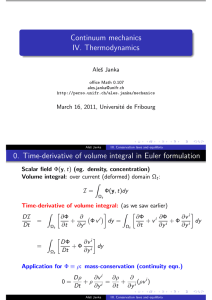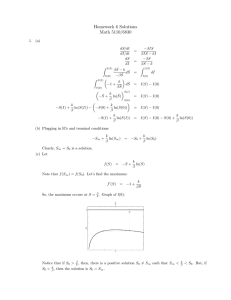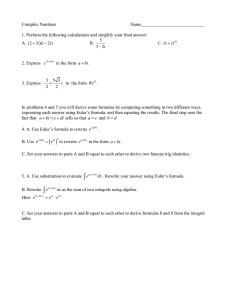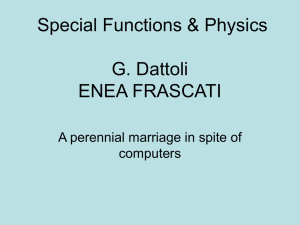III. Conservation laws and mechanical equilibria
advertisement
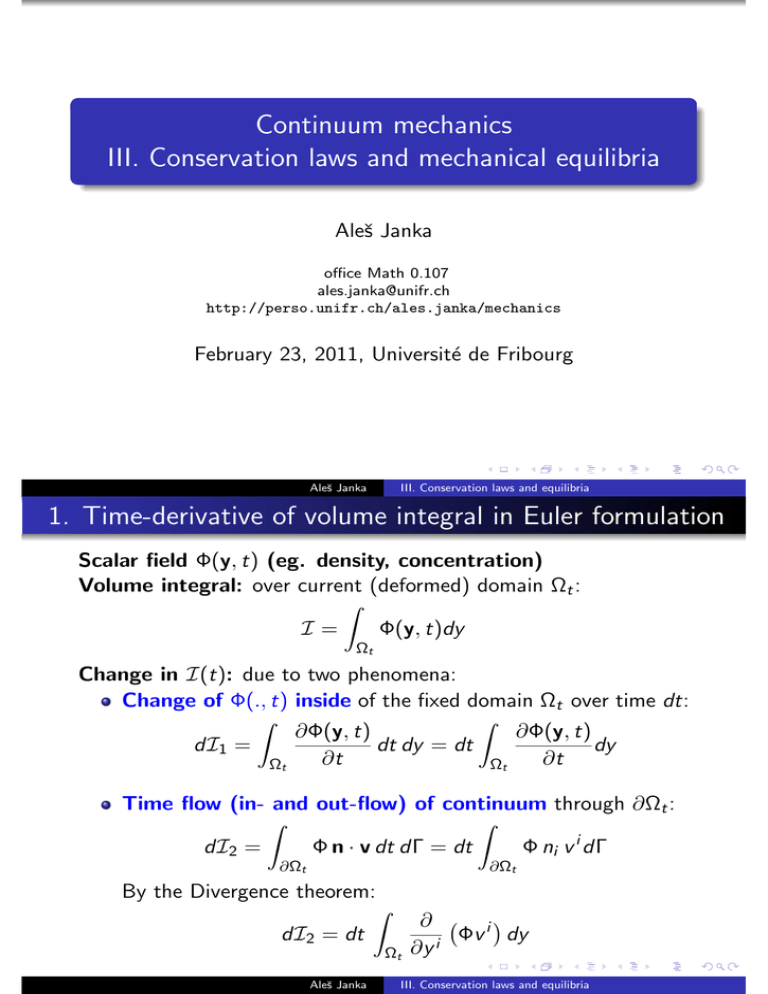
Continuum mechanics III. Conservation laws and mechanical equilibria Aleš Janka office Math 0.107 ales.janka@unifr.ch http://perso.unifr.ch/ales.janka/mechanics February 23, 2011, Université de Fribourg Aleš Janka III. Conservation laws and equilibria 1. Time-derivative of volume integral in Euler formulation Scalar field Φ(y, t) (eg. density, concentration) Volume integral: over current (deformed) domain Ωt : Z I= Φ(y, t)dy Ωt Change in I(t): due to two phenomena: Change of Φ(., t) inside of the fixed domain Ωt over time dt: Z Z ∂Φ(y, t) ∂Φ(y, t) dI1 = dt dy = dt dy ∂t ∂t Ωt Ωt Time flow (in- and out-flow) of continuum through ∂Ωt : Z Z Φ ni v i dΓ dI2 = Φ n · v dt dΓ = dt ∂Ωt ∂Ωt By the Divergence theorem: Z dI2 = dt Ωt Aleš Janka ∂ i Φv dy ∂y i III. Conservation laws and equilibria 1. Time-derivative of volume integral in Euler formulation Time-derivative of volume integral: Z d ∂Φ ∂ DI = (I1 + I2 ) = + i Φ v i dy Dt dt ∂y Ωt ∂t Z = i ∂Φ ∂Φ ∂v + vi + Φ i dy ∂t ∂y i ∂y DΦ ∂v i + Φ i dy Dt ∂y Ωt Z = Ωt Aleš Janka III. Conservation laws and equilibria 2. Mass conservation in Euler formulation Application of the formula for DI Dt : Φ ≡ % is the density: Z DI D% ∂v i ≡0= + % i dy for all Ωt ⊂ Ω Dt ∂y Ωt Dt We can tend Ωt to a point to get the point-form of mass-conservation law (called the continuity equation): D% ∂v i ∂% ∂ 0= +% i = + i (%v i ) Dt ∂y ∂t ∂y Incompressible continuum: D% Dt = 0: ∂v i ie. ρ i =0 ∂y Continuum at steady state: ∂% ∂t = 0: ∂ i ρv =0 ie. ∂y i Aleš Janka div(v) = 0 div(ρv) = 0 III. Conservation laws and equilibria 2. Mass conservation in Lagrange formulation Compare local mass before (Ω0 ) and after (Ωt ) deformation: Z Z %0 (x)dx = %(y)dy Ω0 Ωt ∂y i %(y(x)) · det dx ∂x j Ω0 Z = Continuity equation: ∂y i %0 = % · det ∂x j Aleš Janka III. Conservation laws and equilibria 3. Stress in Euler formulation: Euler stress tensor cut the deformed configuration in two dS0 cutting-plane normal n, ni = n · gi , area dS. ~ g3 n0 ~ g1 delete one of the two parts (eg. the upper one) find a force dF which, applied on a point in dS, simulates the effects of the deleted part dS g3 = e3 ~ g2 e2 =g2 Initial config. y e3 e3 e2 e1 dF depends (linearly) on n and dS dF = τ ij ni gj dS τ ij is the Euler stress tensor Aleš Janka dF g1 = e1 x(y) e1 n III. Conservation laws and equilibria Deformed config. e2 3. Stress in Euler formulation: Euler stress tensor cut the deformed configuration in two dS0 cutting-plane normal n, ni = n · gi , area dS. ~ g3 dS n0 ~ g1 delete one of the two parts (eg. the upper one) g3 = e3 e2 =g2 Initial config. y e3 e3 e2 e1 dF g1 = e1 x(y) find a force dF which, applied on a point in dS, simulates the effects of the deleted part n ~ g2 Deformed config. e2 e1 dF depends (linearly) on n and dS dF = τ ij ni gj dS τ ij is the Euler stress tensor Aleš Janka III. Conservation laws and equilibria 3. Stress in Lagrange formulation: 1st Piola-Kirchhoff cut the deformed configuration in two cutting-plane normal n, ni = n · gi , area dS. dS0 ~ g3 the cutting surface in the initial configuration has a normal n0 and area dS0 . dS n0 ~ g1 g3 = e3 ~ g2 e2 =g2 Initial config. y e3 e1 recopy dF to the initial configuration!! e3 e2 e1 Deformed config. e2 ↑ Euler formulation ↑ dF depends (linearly) on n0 and dS0 dF = σ ij n0i gj dS0 1st Piola-Kirchhoff stress tensor σ ij Aleš Janka dF g1 = e1 x(y) find a force dF which, applied on a point in dS, simulates the effects of the deleted (eg. upper) part n III. Conservation laws and equilibria 3. Stress in Lagrange formulation: 1st Piola-Kirchhoff cut the deformed configuration in two cutting-plane normal n, ni = n · gi , area dS. dS0 g3 = e3 n 0 the cutting surface in the initial configuration has a normal n0 and area dS0 . dS ^ g3 n dF e2 =g2 dF ^ g1 = e1 g2 ^ g1 x(y) Initial config. find a force dF which, applied on a point in dS, simulates the effects of the deleted (eg. upper) part y e3 e3 e2 e1 Deformed config. e2 e1 ↑ Lagrange formulation ↑ recopy dF to the initial configuration!! dF depends (linearly) on n0 and dS0 dF = σ ij n0i gj dS0 1st Piola-Kirchhoff stress tensor σ ij Aleš Janka III. Conservation laws and equilibria 3. Stress in Lagrange formulation: 2nd Piola-Kirchhoff cut the deformed configuration in two cutting-plane normal n, ni = n · gi , area dS. dS0 g3 = e3 n 0 cutting surface in initial config.: normal n0 and area dS0 . dS ^ g3 n dF e2 =g2 ^ g1 = e1 find a force dF which, applied on a point in dS, simulates the effects of the deleted (eg. upper) part g2 ^ g1 x(y) Initial config. y e3 transform dF to dF0 in initial config.: i j ∂x dF0 = dF gi ∂y j dF0 depends (linearly) on n0 and dS0 e1 e3 e2 e1 Deformed config. e2 ↑ 1st Piola-Kirchhoff ↑ dF0 = T ij n0i gj dS0 2nd Piola-Kirchhoff stress tensor T ij Aleš Janka dF III. Conservation laws and equilibria 3. Stress in Lagrange formulation: 2nd Piola-Kirchhoff cut the deformed configuration in two cutting-plane normal n, ni = n · gi , area dS. dS0 g3 = e3 n 0 cutting surface in initial config.: normal n0 and area dS0 . dS dF0 ^ g3 n e2 =g2 ^ g1 = e1 find a force dF which, applied on a point in dS, simulates the effects of the deleted (eg. upper) part g2 ^ g1 x(y) Initial config. y e3 transform dF to dF0 in initial config.: i j ∂x dF0 = dF gi ∂y j dF0 depends (linearly) on n0 and dS0 e3 e2 e1 Deformed config. e2 e1 ↑ 2nd Piola-Kirchhoff ↑ dF0 = T ij n0i gj dS0 2nd Piola-Kirchhoff stress tensor T ij Aleš Janka III. Conservation laws and equilibria 3. Stress: Cauchy vs. 1st/2nd Piola-Kirchhoff tensors How to transform areas dS0 → dS?: Nanson’s relation: dV0 dx ∂x ` dSj = J · dS0` ∂y j dS Initial config. dS0 dy dV i ∂y with J = det . ∂x k x e3 e1 y (x) e2 Deformed config. Relation between Euler and 1st Piola-Kirchhoff: dF i ∂x ` = τ nj dS = τ dSj = τ J dS0` ∂y j = σ i` n0` dS0 = σ i` dS0` ij ij ij ∂x ` σ =τ J ∂y j i` Aleš Janka dF ij III. Conservation laws and equilibria 3. Stress: Cauchy vs. 1st/2nd Piola-Kirchhoff tensors How to transform areas dS0 → dS?: Nanson’s relation: dV0 dx ∂x ` dS0` dSj = J · ∂y j dS Initial config. dS0 dy dV ∂y i . with J = det ∂x k x e3 y (x) e2 e1 Deformed config. Relation between Euler and 2nd Piola-Kirchhoff: dF0j ∂x j ∂x j km ∂x ` k = dF = τ J dS0` ∂y m ∂y k ∂y k = T `j dS0` T `j =τ km ∂x j ∂x ` J ∂y k ∂y m Aleš Janka III. Conservation laws and equilibria 3. Stress: Cauchy vs. 1st/2nd Piola-Kirchhoff tensors How to transform areas dS0 → dS?: Nanson’s relation: dV0 dx ∂x ` dSj = J · dS0` ∂y j dS Initial config. dS0 dy dV i ∂y with J = det . ∂x k x e3 e1 y (x) e2 Deformed config. Relation between 1st and 2nd Piola-Kirchhoff: From relations to Euler stress: T `j =τ km ∂x j ∂x ` J ∂y k ∂y m T `j and =σ Aleš Janka k` σ k` =τ km ∂x ` J ∂y m ∂x j ∂y k III. Conservation laws and equilibria 4. Force equilibria: balance of force and of momentum Body loads: forces on internal points: electro-magnetic field, gravity, acceleration dF i = f i % dV − % ai dV where f i is the body force per unit mass, ai is acceleration and % is density Surface (contact) loads: pressure and drag on the surface: can be expressed by τ ij nj Equilibrium of forces and of momentum of forces (F × x). Euler formulation is more natural for force equilibria than Lagrange formulation Aleš Janka III. Conservation laws and equilibria 4. Force equilibria: Euler formulation Z ω % f i dV + Z ∂ω τ ij nj dS = 0 for any ω ⊂ Ωt By the Divergence theorem: Z ij ∂τ %f i + dV = 0 j ∂y ω We can tend ω ⊂ Ωt to one point to get: ∂ ij τ + %f i = 0 j ∂y in the deformed domain Ωt . Aleš Janka III. Conservation laws and equilibria 4. Force equilibria: Lagrange formulation Using 1st Piola-Kirchhoff stress: and body forces per unit mass of initial configuration: dF0i = f0i %0 dV0 Force equilibrium with 1st Piola-Kirchhoff stress: ∂ ij i σ + % f =0 0 0 ∂x j in the initial configuration Ω0 . Using 2nd Piola-Kirchhoff stress: transform σ ij to T k` : ∂ ∂x ` ∂y k j` T ∂x j k ∂ ∂u j` k k + %0 f0k = T + δ + % f =0 0 0 j ∂x j ∂x ` Aleš Janka III. Conservation laws and equilibria 4. Force equilibria: momentum conditions Euler formulation: momentum equilibrium about the origin: Z Z y × % f i gi dV + y × τ ij nj gi dS = 0 ω ∂ω Levi-Civita symbol: +1 if (i, j, k) is an even permutation of (1, 2, 3) −1 if (i, j, k) is an odd permutation of (1, 2, 3) ijk = 0 if i = j or i = k or j = k Properties of the Levi-Civita symbol: a×b=c ci = εijk aj b k . ⇔ Hence for moment equilibrium: Z Z εijk y i % f j dV + εijk y i τ j` n` dS = 0 ω ∂ω Aleš Janka III. Conservation laws and equilibria 4. Force equilibria: momentum conditions By the Divergence theorem: Z Z εijk y i % f j dV + ω ω ∂ i j` εijk y τ dS = 0 ∂y ` Work-out the derivative in the second term to get: j` Z Z ∂τ + % f j dV + εijk δ`i τ j` dV = 0 εijk y i ` ∂y ω ω As the red term is 0 by component-wise conditions, momentum conditions reduce to εijk τ ji = 0 ∀k = 1, 2, 3. By definition of the Levi-Civita symbol, this means: τ 12 = τ 21 , τ 13 = τ 31 , τ 23 = τ 32 Euler and 2nd Piola-Kirchhoff stress tensors are symmetric! Aleš Janka III. Conservation laws and equilibria 5. Transformation of tensors Lagrange ↔ Euler Deformation gradient: ∂y i i Fj = ∂xj i F−1 j ∂x i = ∂yj ∂y i J = det ∂xj Strain tensors: Lagrange ↔ Euler εk` = Fki · Eij · F`j Stress tensors: Lagrange (2nd Piola-Kirchhoff stress) ↔ Euler j i T ij = J · F−1 k · τ km · F−1 m Aleš Janka III. Conservation laws and equilibria
